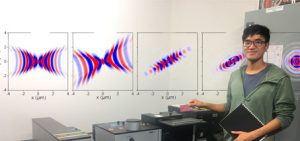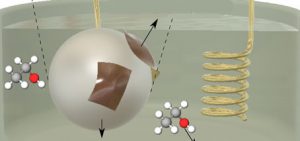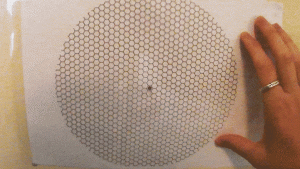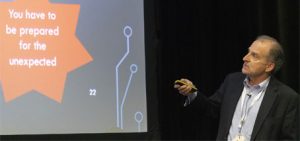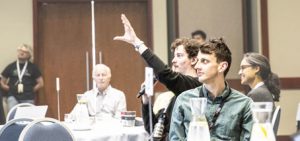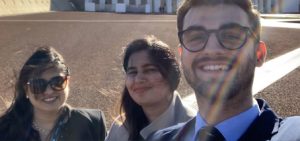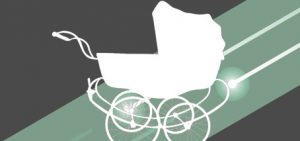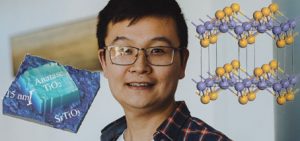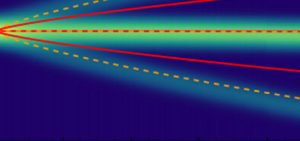Engage
See news from around FLEET, below
Catch up on all past issues of FLEET News newsletter
FLEET News
‘Twisted’ layers of 2D materials produce photonic topological transition at ‘magic’ rotation angles Principles of Moire-pattern bilayer graphene applied to 2D material photonics for first time Monash researchers are part of an international collaboration applying ‘twistronics’ concepts (the science of layering and twisting 2D materials to control their electrical properties) to manipulate the flow of light in extreme ways. The …
CSIRO Chief Scientist Dr Cathy Foley was recognised in this year’s Queen’s Birthday Honours for her distinguished service to research science, to the advancement of women in physics and to professional scientific organisations. Prior to becoming Chief Scientist, as Deputy and Science Director of CSIRO Manufacturing, Dr Foley worked to engage Australian manufacturers and researchers to translate research into economic …
For the first time, FLEET researchers at UNSW, Sydney show the synthesis of ultra-thin graphitic materials at room temperature using organic fuels (which can be as simple as basic alcohols such as ethanol). Graphitic materials, such as graphene, are ultra-thin sheets of carbon compounds that are sought after materials with great promises for battery storage, solar cells, touch panels and …
A recent FLEET homescience exercise explained how simple geometric patterns printed on transparency (‘overhead projector sheets’, to those of us old enough to remember such technology), and overlaid at varying angles, produced a combined ‘Moire’ pattern of varying dimensions. Two sheets of repeating squares produces a Moire pattern of larger squares. Two sheets of repeating triangles produces a Moire pattern …
A panel of experts featuring Dr Paolo Gargini (formerly Intel, head of several international semiconductor roadmaps), Prof Michelle Simmons (UNSW, Director. ARC Centre for Quantum Computation and Communication Technology) and Prof Michael Fuhrer (Monash Uni., Director of ARC Centre of Excellence in Future Low Energy Electronics Technologies.) and a guided discussion about the future of electronics beyond CMOS and the role semiconductors and other materials …
It is a great pleasure to announce that Dr Julie Karel (Monash) is now a FLEET Chief Investigator. Dr Karel conducts research at the intersection of materials science and condensed-matter physics, to develop new materials for emerging low-energy nanoelectronic and magnetoelectronic devices. Within FLEET Dr Karel will pursue two research streams: Modification of materials through ionic liquid gating, towards FLEET’s goal …
Working towards the overarching goal of creating pathways to translations of research outcomes, FLEET is building links with partners interested in novel electronic devices and systems. Progress towards this important goal in 2019 includes: Working to include topological transistors in the Institute of Electrical and Electronics Engineers’ (IEEE) International Roadmap for Devices and Systems Lodging two provisional patents Collaborating on …
FLEET ensures that our young researchers are prepared for future success – wherever their career takes them. The Centre currently supports 51 higher degree by research (HDR) students and 43 postdoctoral researchers with another 29 research affiliates working on FLEET projects and invited to Centre training, workshops and events. FLEET connects its researchers with internal and international networks; for example, …
Engaging with politicians and other policymakers is key for any Centre of Excellence, and pitching to politicians is a key skill for researchers, whether they are senior or just starting their career in research. In 2019, three FLEET ECRs were fortunate to attend Science Meets Parliament. Each proved to be remarkably adept at briefing members of the House of Representatives …
FLEET endeavours to lead change within the Australian science community. We believe that all conferences and workshops must work for researchers with families, rather than the other way around. FLEET’s annual workshops are unusual in that families and partners are welcomed to all meals and social events, and free on-site childcare is provided for all delegates. Involving families and children …
An international FLEET collaboration publishing a review of atomically-thin ‘high temperature’ superconductors finds that each has a common driving mechanism: interfaces. The team, including researchers from the University of Wollongong, Monash University and Tsinghua University (Beijing), found that interfaces between materials were the key to superconductivity in all systems examined. The enhancement of superconductivity at interfaces (interface superconductivity enhancement effect) …
Congratulations to FLEET’s Maciej Pieczarka, who has been awarded the START award for young Polish scientists by the Foundation for Polish Science. Dr Pieczarka is an experimental physicist working as a postdoctoral research fellow at the Australian National University in Prof Elena Ostrovskaya’s group. Within FLEET, Maciej studies exciton-polariton condensates, focusing on dynamical condensation and phase transitions of exciton-polariton fluids …
While FLEET’s aim is to reduce the world’s ICT power consumption, we also know that some of the work we do today is having a detrimental effect on tomorrow’s environment. Initiated by FLEET ECRs, the Centre’s Environmental working group is taking a microscope to the environmental impact of FLEET. One early output has been a tool to calculate and compare …
A new theoretical study at Monash University has improved our understanding of the interplay between quantum and thermal fluctuations (or excitations) in quantum matter. The study found that an impurity within a Bose-Einstein condensate (BEC) exhibits an intriguing energy spectrum as its temperature is raised above zero kelvin, with the ground-state quasiparticle splitting into a number of branches that depends …
FLEET Partner Investigator Kirrily Rule (ANSTO) introduced an audience of over 100 to the use of neutron scattering in material analysis last week, in a live-streamed seminar co-hosted with the Australian Institute of Physics. Neutron scattering is a powerful tool for investigating the structure and dynamics of condensed matter systems. In particular the magnetic spin of the neutron can interact …

